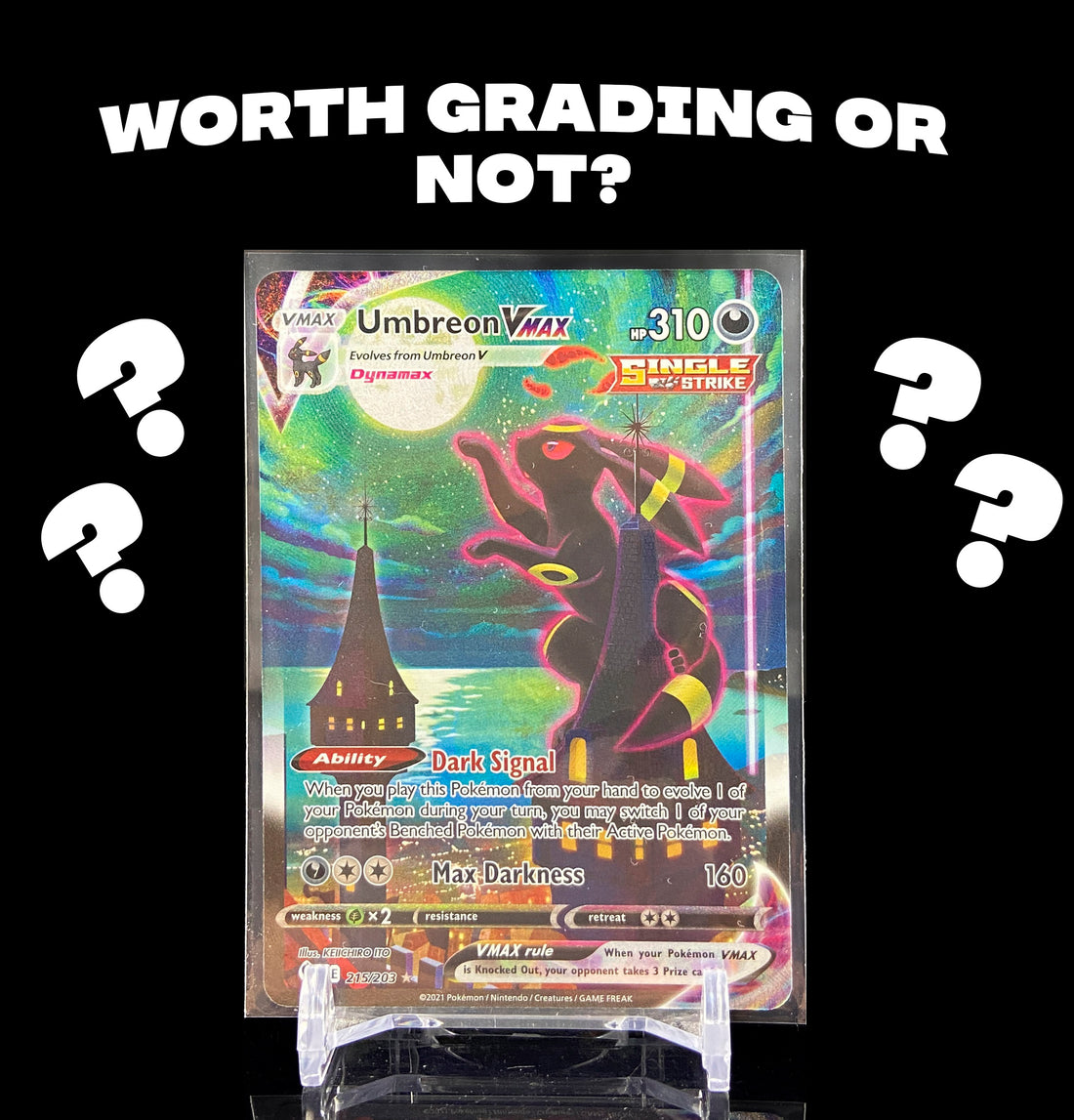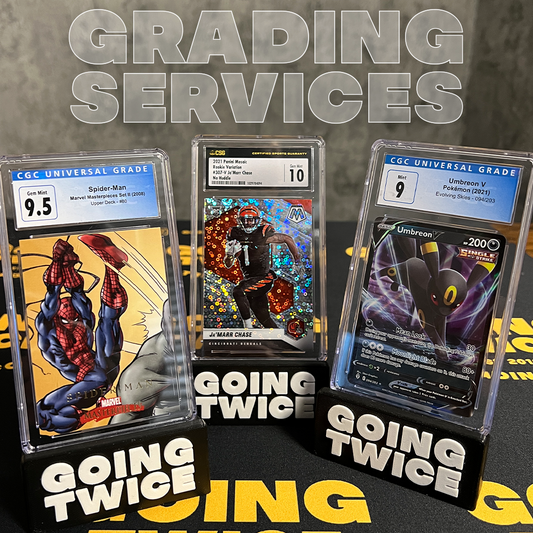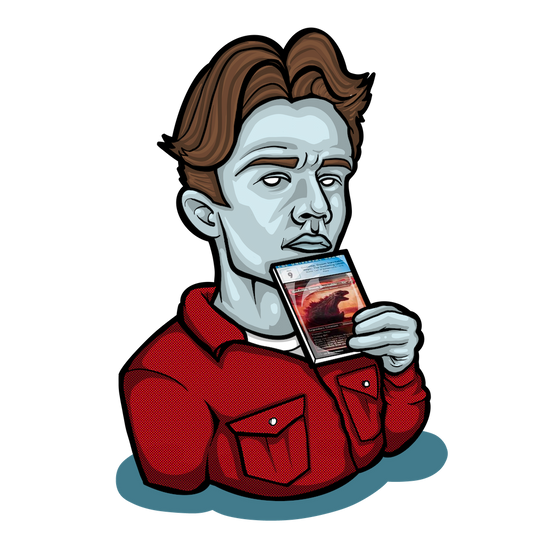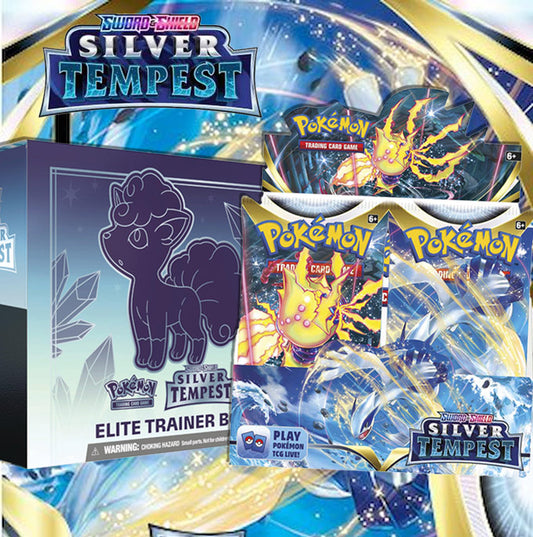
How to Determine if a Pokemon Card is Worth Grading
Share
So you're interested in grading your Pokemon cards... Where to start? Is it worth it? How long will it take? What's involved? This guide will help you answer those questions and we'll use some actual examples and go through the entire process from evaluating the condition of the cards, determining the raw and expected graded value of the cards, choosing a grading company, and submitting (or not) the cards to grading. We'll even update this article when we get the cards back from grading to see how we did.
What factors to consider when grading Pokemon cards
When evaluating Pokemon cards for grading there are a couple of things that are important to consider, we'll break each one down in more detail and then put it into practice with a couple of example cards.
Condition
The condition of the raw (ungraded) card is critical when determining if grading is worth it. Check out our Guide to How Grading Works for detailed information about the grading scales and criteria for PSA, CGC, and BGS. The four main criteria are centering, corners, edges, and surface. There is also the more ambiguous eye appeal that is factored in on top of that in many cases. It is difficult to accurately assess condition without the tools and knowledge that a professional grader has but it is still worth coming up with your best guess about a card's raw condition. Some tips are to look at your card under a bright light, from multiple angles, and with magnification (if possible). With careful examination, you should be able to spot obvious issues and hopefully the more subtle ones as well. There is nothing worse than thinking you are grading a Gem-Mint 10 and getting a lower than expected grade back.
Value
The value of the card versus the value of the card graded are two important considerations when determining if a card should be graded or not. The value of the raw (ungraded) card is a tricky thing because until the card is graded, the condition is an unknown. We can try to categorize the card into the standard condition levels but that can be a subjective thing. For our raw condition standards, we are going to refer to those put forth by TCG Player who as one of the largest online sellers of raw TCG cards, is considered a market standard. You can also check out their very in-depth guide to Card Condition Standards for more detailed information. Raw condition is generally broken down into these standards:
- Near Mint (NM): Card shows minimal wear from play or handling and should have a nearly unmarked surface, clean corners, and edges with no whitening. There can be very slight edge wear or a few minor scratches but no major defects.
- Lightly Played (LP): Card shows minor border or corner wear with some scuffs or scratches. There should be no major defects (bends, creases, etc), only a few minor imperfections.
- Moderately Played (MP): Card shows border and/or corner wear, scratching, scuffing, and some creases or whitening. The imperfections should affect a small area of the card and should not impact the card's overall integrity.
- Heavily Played (HP): Card shows a major amount of wear. The imperfections impact the integrity of the card such as creasing, whitening, and bends. Card may still be playable when sleeved.
- Damaged: Card shows wear and imperfections beyond HP and would not be playable even in a sleeve. Damage can include large creases, folds, tears, etc.
To find the raw value of your card, you would categorize it into one of the above categories and then research listed (currently for sale) and sold prices for the card in that condition. TCG Player is a good place to find verified sold data as is eBay.
Next you would want to determine approximately what grade you think the card would receive graded and see the expected graded value of that grade. Check out our article on How Grading Works for Pokemon Cards for a break down of the grading criteria and the grading scales for the 3 major Pokemon grading companies (PSA, CGC, and BGS). The leap from raw condition to grade is a tricky one as the grader will be examining your card very closely using magnification and wealth of experience assessing cards. I recommend evaluating your card for best to worst case by valuing it at several potential grades. For example, if I think the card will grade a Near Mint 9, I'm also going to consider that it might get an 8.5, 8, or even a 7. To find the graded value, you can research sold prices (safer bet then looking at current, for-sale listings) on eBay, Heritage Auctions, PWCC, or Goldin Actions. All of those platforms have slightly different customer bases with eBay being the most common place to buy and sell graded cards. While doing this research, you may find that cards graded by different grading companies command a different price (CGC vs PSA vs BGS for example) and that should factor into your decision about where to grade. In this article, we will not delve into pop reports or how to go about researching prices, that we will save for a future article. You should also take a look at current prices for each of the major grading companies, their requirements for how many cards need to be submitted at a time, and their turnaround time (how quickly you'll get your card back). Check out our article "What Pokemon Card Grading Service is Best?" for details on all of those things. Turnaround time may be a critical factor when choosing a grading company as the card may gain (or lose) value during the time that it is going through the grading process.
Is grading worth it?
Once you have determined the current raw value of your card versus the expected graded value, you can now think about whether grading is worth it. Keep in mind that your motivations for grading also come into play here. If you are grading to preserve the card's condition through the encapsulation process or to authenticate it or to know it's 'real' condition, it may be worth it despite the value gained (or lost) in grading. If it is for your personal collection, you may also want to grade despite the grade outcome. If the goal is to make money selling the card after grading, you will want to carefully weigh your options. In another articles, we will take a deep dive into researching prices but will skip the details here for the sake of brevity.
Basic Value Equation:
- Worth Grading: Raw card value (cost of raw card + grading fees (mentally include turnaround times and changes in the market during that time) < graded value of the card (include worst case scenario grade up to best case scenario grade)
- Maybe Worth Grading: Raw card value (cost of raw card + grading fees (mentally include turnaround times and changes in the market during that time) = graded value of the card (include worst case scenario grade up to best case scenario grade)
- If this card is meaningful to you, meant to be part of your personal collection, or you're concerned with preservation or authentication, it's probably still worth it.
- Not Worth Grading: Raw card value (cost of raw card + grading fees (mentally include turnaround times and changes in the market during that time) > graded value of the card (include worst case scenario grade up to best case scenario grade)
- Only worth grading if this card is meaningful to you, meant to be part of your personal collection, or you're concerned with preservation or authentication.
Grade with Going Twice
If you want to hand over the grading process to an Authorized CGC Dealer, Going Twice is happy to help! We offer grading for Pokemon, TCG, and Sports cards through CGC. See more information on our Grading page!
Test Cases for Pokemon Card Grading
Okay, now that we know the basics, let's take a look at some real world examples from my personal collection and run through the whole process with each. I'll update this article once I receive the cards back from grading.
Umbreon VMAX (Alternate Art Secret), Evolving Skies, 215/203
Up first we have the very beautiful artwork of the "Moonbreon" Alternate Art from Evolving Skies. This is a highly sought after card at the moment and my son was lucky enough to pull one out of a Charizard UPC when they came out. Now this card (like many modern Full Art cards) is tricky to judge condition on the front because of the texture of the card but also tends not to show print lines or scratches as easily (depending on the background color/pattern).
Note: the image provided are to give you a general idea of the condition of the card but do have some dust on them and glare on the sleeves.


Let's assess the general criteria that the card will be graded on:
- Centering: The front centering is notoriously difficult to judge on this kind of full art card but I think it looks pretty good. The back centering on the other hand, it noticeably off top to bottom with more border on the top.
- Corners: The corners look crisp front and back with no noticeable nicks or weird cuts.
- Surface: The surface looks good to the naked eye with no creases, dents, marks/stains, or scratches.
- Edges: The edges also look crisp front and back with no whitening or obvious issues.
Let's take a look at the numbers that will factor into our decisions:
Cost:
- Cost to pull the card: $120 Charizard Ultra Premium Collection Box
- Grading: Bulk grading with CGC: $15 (must be submitted in larger lot)
- Shipping to and from grading (part of larger lot): $2
Total cost to own & grade: $137.00
Values:
- Raw Value (based on TCG Player last sold prices): Near Mint $500 average
- CGC 10 last sold on eBay average: $1000
- CGC 9.5 last sold on eBay average: $700
- CGC 9 last sold on eBay average: $500
- CGC 8.5 last sold on eBay average: $400
As you can see from the market values, if the card hits a 9 or lower, I might be better off selling the card raw (if that is my ultimate goal with the card). A second risk in grading is that the card might sit at the grading company for long enough that more of these cards hit the market and there is less demand, driving down the price as a result. One of the reasons I like CGC is the quick turnaround so that is less of an issue here. This card is for my personal collection so I will take the gamble on grading.
Umbreon GX (Secret Rare), Sun & Moon Base set, 154/149
Next we have this lovely Full Art Rainbow Secret rare Umbreon from SM Base set. My son pulled this card out of a loose booster pack from Sun & Moon. While still a great card, it does not reach the same level of hype as the previous Umbreon.


Let's assess the general criteria that the card will be graded on:
- Centering: The front centering is not great on this card with a heavier border on the right and bottom edges. The back centering is a tiny bit heavier on the bottom but overall, pretty good.
- Corners: The corners look crisp front and back with no noticeable nicks or weird cuts.
- Surface: The surface looks good to the naked eye with no creases, dents, marks/stains, or scratches.
- Edges: The edges also look crisp front and back with no whitening or obvious issues.
Let's take a look at the numbers that will factor into our decisions:
Cost:
- Cost to pull the card: $4 SM Booster pack
- Grading: Bulk grading with CGC: $15 (must be submitted in larger lot)
- Shipping to and from grading (part of larger lot): $2
Total cost to own & grade: $21.00
Values:
- Raw Value (based on TCG Player last sold prices): Near Mint $35 average
- PSA 10 (no comps for CGC) last sold on eBay average: $100
- CGC 9.5 last sold on eBay average: no data
- CGC 9 last sold on eBay average: $35
- CGC 8.5 last sold on eBay average: $30
As you can see from the market values, if the card hits a 9 or lower, I would be better off selling the card raw (if that is my ultimate goal with the card). This card is for my son's personal collection so I will take the gamble on grading.
Light Jolteon, Neo Destiny, 48/105
Our last card in this experiment is a non-holo vintage Light Jolteon from Neo Destiny. Other than being completely adorable, this card does not have anything extra special about it that commands a premium price.


Let's assess the general criteria that the card will be graded on:
- Centering: The front and back centering on this card look pretty good.
- Corners: The corners have a little bit of whitening on the back and one corner is not a smooth cut - it's a little jagged.
- Surface: The surface looks good to the naked eye with no creases, dents, marks/stains, or scratches.
- Edges: The edges have minor whitening on the back.
Let's take a look at the numbers that will factor into our decisions:
Cost:
- Cost to pull the card: free - found it in a binder
- Grading: Bulk grading with CGC: $15 (must be submitted in larger lot)
- Shipping to and from grading (part of larger lot): $2
Total cost to own & grade: $17.00
Values:
- Raw Value (based on TCG Player last sold prices): Light Play $17 average
- PSA 9 last sold on eBay average: $65
- PSA 7 last sold on eBay average: $20
There was very little sales data for this card in the unlimited version so it is hard to assess a true re-sale value.
As you can see from the market values, if the card hits a 7 or better, grading is the better option than keeping it raw. Vintage cards, even non-holos can fetch good prices because there are less of them out there in good condition.
Final Thoughts
There are obviously a lot of factors that go into the decision to grade or not to grade from preserving the quality and condition of a card for your personal collection or trying to make money through achieving a certain grade. After



